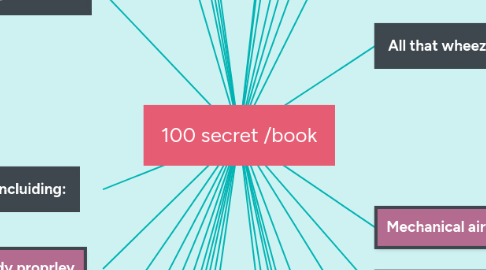100 secret /book
por Hassan Alhjeeme

1. The newborn heart less complaint cause it's less mature \ less responsive to inotropic support \ myocardial mature complete 6-12 months age
2. Ketamine best inducation agent for patients with :
2.1. elevated intracranial pressure [ICP]
2.2. hypovolemic trauma
2.3. acrive bronchospastic disease
3. Propfol uses:
3.1. Adult patients with docomunted egg allergies
3.2. Should avoided in children with anaphylaxis to egg
4. Local anesthetic agents :
4.1. Esters
4.2. Amides
5. Local anesthetic
5.1. Inuced
5.1.1. CNS toxicity
5.1.1.1. Manifests with excitation
5.1.1.2. Seizures
5.1.1.3. Loss of conscious
5.1.2. Cardiac toxicity
5.1.2.1. Happens after CNS toxicity
5.1.2.2. Hypotension
5.1.2.3. Conduction blockade
5.1.2.4. Dysrhythmias
5.1.2.5. Cardiac arrest
5.2. It's toxicity treated with lipid emulsion therapy /ex: intralipid 20%
6. Adequate oxygenation
6.1. Controlled Postperative pain
6.2. Resolved postperative nausea and vomiting
6.3. Required for postanesthesia unit discharge
7. Glocuse control before,,during and after surgery important for:
7.1. Reduce the risk of wound infection
7.2. Promote rapid wound healing
7.3. Avoid metabolic complications and shorten hospital stay
7.4. Insulin goal:90-180 mg/dl , during most surgicalm operations
8. PONV: postperative nausea and vomiting
9. Chronic exogenous glucocorticoid therapy should not be discontinued abruptly
10. The shoulder primarily supplied by:
10.1. Superiorly : suprascapular nerve
10.2. Both can anesthetize by interscalene block and it's first complications is ipsilateral phrenic nerve block result in:
10.2.1. Hemidiaphragmatic paralysis
10.2.2. Horner syndrome
10.2.3. unilateral recurrent laryngeal nerve paralysis
10.2.4. Pneumothorax \ air in pleural cavity ,chest cavity
10.2.5. inadvertent neuraxial injection\الحقن العصبي غير المقصود
10.2.6. Accidental intravascular injection
10.3. Inferiorly : axillary nerve
11. Regional anesthesia is beneficial for patients with:
11.1. Whom general anesthesia should be avoided
11.2. Whom pain may be difficult to control
11.3. Ex: patients with severe cardiopulmonary disease, PONV , obstructive sleep apnea ,chronic pain, subctance abuse
12. Age-related physiological changes include:
12.1. Left ventricular hypertrophy
12.2. Increased reliance on preload for cardiac output
12.3. Decreased venous compliance
12.4. Increased closing capacity
12.5. Decreased glomerular filtration rate
12.6. Decreased hepatic function
12.7. Increased risk for postoperative delirium
13. Reason to give intravenous fluid is to increase stroke volume
13.1. Use frank-starling law to predict volume responsiveness
14. Patients with reactive airway disease [ex: asthma] require through preoperative preparation incluiding:
14.1. Inhaled β-agonist therapy
14.2. Possibly steroids
15. All that wheezes is not asthma but also consider :
15.1. Mechanical airway obstruction
15.2. Congestive failure
15.3. Allergic reaction
15.4. Pulmonary embolus
15.5. Pneumothorax
15.6. Aspiration
15.7. Endobronchial intubation
16. Congestive failure:heart not able to pump blood around body proprley
17. Mechanical airway obstruction : any solid object work as foreign body and cause airway obstruction
18. Aspiration : to draw in or out using a sucking motion
19. Pulmonary embolus [PE] : is a blood clot that develops in a blood vessel elsewhere in the body [often th leg] travels to an artery in the lung and suddenly forms a blockage of the artery
20. Pneumothorax : when the lung collapsed due to air entering the pleural space
21. TEG: thromboelastography
22. ROTEM: rotational thromboelastometry
23. Agents types:
23.1. Depolarizing agents : Succinylcholine
23.2. Nondepolarizing agents: steroid agents[vecuronium, rocuronium]
23.3. Benzylisoquinolinium agents: [atracurium, cisatracurium]
23.4. Phase 1 : block with depolarizing agents
23.5. Phase 2 : block with nondepolarizing neuromuscular blocking agents
24. The best practice to ensure termination of the relaxant effect from neuromuscular blocking agents are:
24.1. Dose them sparingly
24.2. Allow enough time for normal metabolism to occur
25. It is best practice to administer reversal agents to all patients receiving nondepolarizing neuromuscular blocking agents unless the T4:T1 is greater than 0.9
26. If for some reason a patient is not recovering from neuromuscular blockade , they should remain intubated on supported ventilation until they can demonstrate return of strength
27. Cardiotoxicity because of hyperkalemia should be immediately treated with intravenous calcium chloride or calcium gluconate
28. Nonanion gap metabolic acidosis: hyperchloremia/ eleoctrolyte impalance occurs when there's to kuch blood chloride in the blood
29. Patients who receive high volumes fluid , especially normal saline , often develop hyperchloremia and a nonanion gap metabolic acidosis
30. MAC: minimum alveolar concentration
30.1. Is defined as the minimum alveolar concteration of inhaled anesthetic required to prevent movement in 50% of patients in response to surgical incision
31. The MAC of inhaled anesthetic decreased in cases :
31.1. old age or premature
31.2. Hyponatremia/ sodium level in blood less the normal
31.3. Hypothermia/ the body begins to lose heat faster than it's produced/ cause : prolonged exposures to to very cold temperatures / leads to lower body temperature
31.4. Opioids / illegal and legal drugs
31.5. Barbiturates / affecting the inhibitory neurotransmitters in the brain
31.6. α2 blockers
31.7. Calcium channel blockers
31.8. Acute alcohol intoxication
31.9. Pregnancy
32. The MAC increased by:
32.1. Hyperthermia
32.2. Chronic alcoholism
32.3. Hypernatremia /high sodium levels in blood
32.4. acute intoxication with CNS stimulants (e.g., amphetamine)
33. Nitrous oxide should not be used in:
33.1. Setting of pneumothorax
33.2. Bowel obstruction
33.3. Pneumocephalus
33.4. During middle ear or opthalmological surgeryl / eye surgery
34. Hypoxemia / low oxygen level in blood/ causes :
34.1. Low inspired oxygen
34.2. Alveolar hypoventilation
34.3. V/Q mismatch
34.4. Right-left shunt
34.5. Impaired oxygen diffusion


